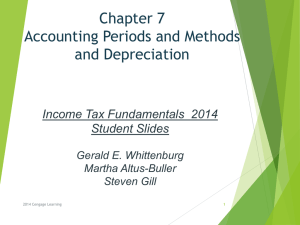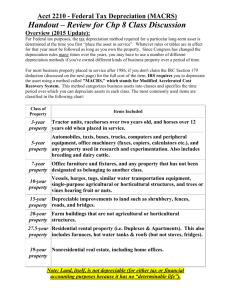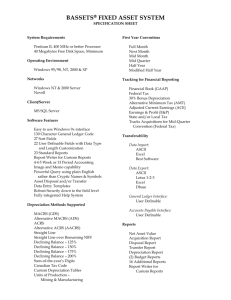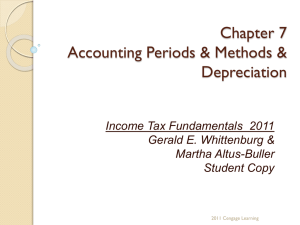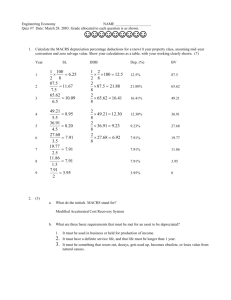Chapter 7 Accounting Periods and Methods and Depreciation
advertisement
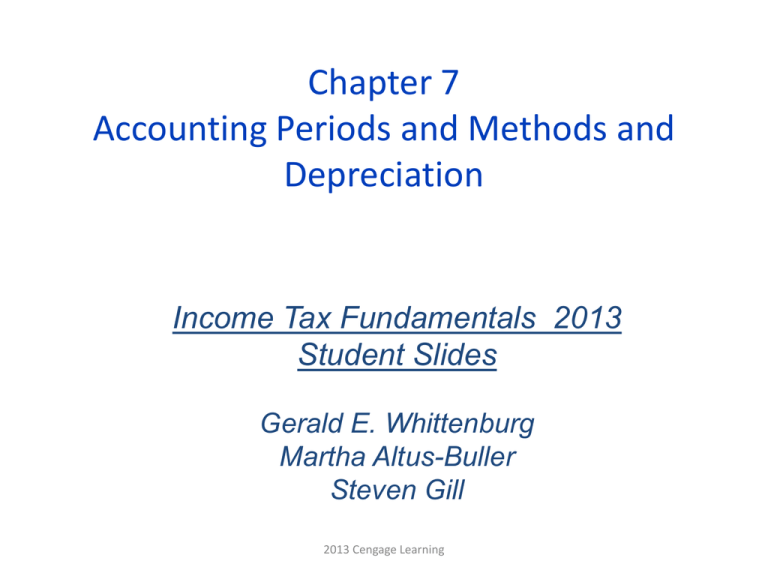
Chapter 7 Accounting Periods and Methods and Depreciation Income Tax Fundamentals 2013 Student Slides Gerald E. Whittenburg Martha Altus-Buller Steven Gill 2013 Cengage Learning Accounting Periods Most individuals file tax returns that utilize a calendar year Most partnerships, S corporations, and personal service corporations owned by individuals have same calendar year as almost all individuals In these entities Allowed a September, October, or Novembe year-end if owners make tax deposit Beyond scope of this text Note: Partnerships don’t pay tax as an entity 2013 Cengage Learning Accounting Methods There are three acceptable accounting methods for reporting taxable income o o o Cash Hybrid Accrual must use same method for tax & books Must use one method consistently o o Make an election on your first return by filing using a particular method Must obtain permission from IRS to change accounting methods 2013 Cengage Learning Depreciation Depreciation is a process of allocating and deducting the cost of assets over their useful lives ◦ Does not mean devaluation of asset ◦ Land is not depreciated Maintenance vs. depreciation ◦ Maintenance expenses are incurred to keep asset in good operating order ◦ Depreciation refers to deducting part of the original cost of the asset Report depreciation on Form 4562 2013 Cengage Learning Depreciation Methods Straight-line depreciation is easiest, for accounting purposes, and is calculated as (Cost of asset – salvage value)/Years in estimated life Modified Accelerated Cost Recovery System (MACRS), for tax purposes, allows capital assets to be written off over a period identified in tax law ◦ Accelerated method used for all assets except real estate 2013 Cengage Learning Personal Property Recovery Periods With MACRS, each asset is depreciated according to an IRSspecified recovery period ◦ 3 year ◦ 5 year ◦ 7 year ADR* midpoint of 4 years or less Computers, cars and light trucks, R&D equipment, certain energy property and certain equipment Mostly business furniture and equipment and property with no ADR life *See Table 7.1 on page 7-9 for Asset Depreciation Ranges (ADR) for recovery periods for all classes of assets 2013 Cengage Learning Calculating Depreciation for Personal Property Depreciation is determined using IRS tables ◦ MACRS rates found in Table 7.2 on page 7-10 ◦ Rates multiplied by cost (salvage value not used in MACRS) ◦ Tables based on half-year convention Means 1/2 year depreciation taken in year of acquisition and 1/2 year taken in final year May elect to use tables based on straight-line instead (percentages in Table 7.3 on page 7-11) Note: Must use either MACRS or straight-line for all property in a given class placed in service during that year 2013 Cengage Learning Real Estate Real assets depreciated based on a recovery period – 2 types of real property o o o 27.5 years 39 years Residential real estate Nonresidential real estate Real assets are depreciated using the straightline method with a mid-month convention Mid-month convention assumes all purchases made in middle of month Used for real estate acquired after 1986 Rates found on Table 7.4 on page 7-13 Note: Different rates apply for real property acquired before 1981 and after 1980 but before 1987 2013 Cengage Learning Election to Expense - §179 §179 allows immediate expensing of qualifying property (tangible personal property used in a business, new or used) o For 2012, the annual amount allowed is $139,000 (this amount may increase in final weeks of 2012; see Whittenburg companion web site for updated information) §179 election to expense is limited by 2 things o If cost of qualifying property placed in service in a year > $560,000, then reduce §179 expense dollar for dollar • For example, if assets purchased in current year = $662,000, taxpayer must reduce §179 by $102,000. Therefore, election to expense is limited to = $37,000 ($139,000 – 102,000). The remaining $625,000 of basis is depreciated over assets’ useful lives (including bonus depreciation) if applicable. o Cannot take §179 expense in excess of taxable income 2013 Cengage Learning Listed Property Special rules exist to limit deductions on assets that lend themselves to personal use, called ‘listed property’ ◦ Cars and trucks/vans under 6000 lbs. gross vehicle weight with specific exclusions ◦ Computers (unless used exclusively at business) ◦ Equipment used for entertainment, recreation or amusement If asset used <= 50% for business (or if business use falls below 50% in subsequent years) must use straight-line and election to expense not allowed If asset used > 50% for business, must use MACRS Separate section (Part V) on page 2 of Form 4562 2013 Cengage Learning
